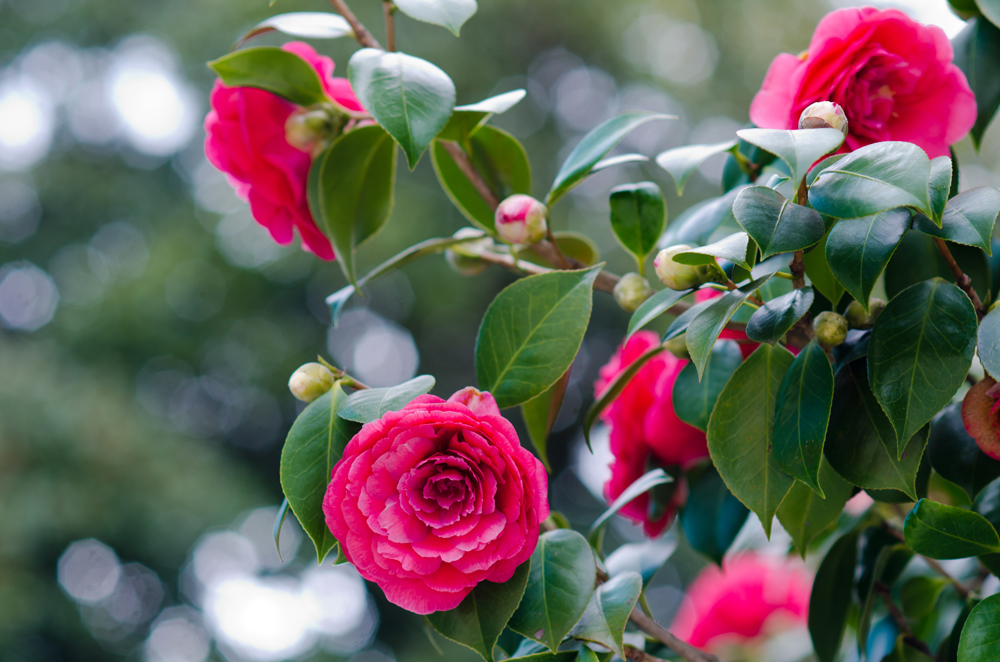Camellia sp.
Common Name:
Camellia

General information:
The most famous member of the Camellia family is C. sinensis, the plant from which we get tea. Tea can be made from other Camellia species, but its flavor is not as desirable. But these other Camellias make showy bonsai, with beautiful flowers and shiny evergreen leaves. They can be grown outdoors in warm climates, and are often grown as an indoor bonsai when they cannot be kept otherwise. Most Camellias flower from fall through early spring.
When flower buds begin to appear, they are delicate. They may fall off if the plant is moved, or if there is too great a variation in temperature or light.
Lighting:
Partial shade to full sun.
Temperature:
Zone hardy to zones 8 or 9, depending on species. Never below 10F. Can be grown successfully indoors, but needs cool nights (between 40-60F, but 50-59F is best) in winter. Likes ventilation, but should be kept sheltered from strong winds.
Watering:
Moderate, but as the root hairs are very fine, the plant CAN NOT be allowed to dry completely. Increase watering during active growth, and when the plant is in bloom. It is best to use decalcified (soft) water if possible. Likes an occasional misting, but do not mist while in bloom or the flowers will wither.
Feeding:
Every 2-3 weeks, spring-autumn. Use a fertilizer such as Miracid, formulated for acid-loving plants, at half- strength. Do not fertilize while the plant is in bloom. The plant may also benefit from administering chelated iron 2-3 times a year.
Pruning and wiring:
Wire from late spring to autumn, taking care to protect the delicate bark and branches. Do not wire while the plant is setting buds, and wire only lignified shoots. Young plants should be pruned after the shoots have developed 4-6 leaves, trimming back to 2-3 to establish branching. Pruning of established bonsai is best done following flowering, pruning only once and then allowing new shoots to set buds.
Propagation:
By seed, soaking in warm water, for 24 hours, and then removing the outer casing. Fast germinating. Also hardwood cuttings can be taken from winter-summer, although rooting is slow and difficult. The use of rooting hormone and bottom heat of 72F is recommended. Air-layering is possible.
Repotting:
Every 2-4 years in late winter or spring, following blooming. Likes acidic, humus rich soil. The roots are superficial and fine, so drastic root pruning is not recommended, and it is best if only 10% of the roots are removed.
Pests and diseases:
Camellia is vulnerable to aphids, red spider mites sooty mould, weevils and chlorosis.
Some species suitable for bonsai:
Camellia cuspidata - Reputed to be somewhat more hardy than the other members of the species, this plant has abundant small white flowers.
Camellia japonica: camellia, common camellia - This is the most widely grown species. Although best known as a shrub, it can grow into a tree over 30 feet tall. It has oval leaves up to 4 inches, and most generally grows in zones 7-9 although some cultivars have been grown as far north as southern New York. It is best known for its spectacular blooms, which occur in late winter or early spring, and can be white, pink or red. There are numerous cultivars, generally selected for their various flowers.
Camellia maliflora - A small flowered variety.
Camellia reticulata - A small-leaved, shade-tolerant Camellia. It is hardy to zone 9. The white, pink or red flowers can be found both single and double. Aggressive pruning is needed to promote branching. Camellia sasanqua: Sasanqua camellia - Smaller than japonica, this Camellia has two inch leaves and flowers, and grows only to 12 feet. Like C. japonica, it is hardy in zones 7-9, and has many cultivars. Camellia sinensis: tea, tea plant, tea bush - A white flowered variety, its small leaves and flowers make it better proportioned for bonsai than other Camellia species.
Camellia taliensis
Camellia tsaii - another small flowered Camellia.
Camellia vernalis: Vernalis camellia
Compiled by Sabrina Caine
